A Miniaturized Full-Ground Dual-Band MIMO Spiral Button Wearable Antenna for 5G and Sub-6 GHz Communications
Abstract
:1. Introduction
2. Antenna Configuration
2.1. Antenna Geometry
2.1.1. Spiral Button Antenna
2.1.2. Flexible Wearable LWA
3. Results and Discussion
3.1. Antenna Performance for Off-Body Condition
3.2. Antenna Performance for On-Body Condition
4. Conclusions
Author Contributions
Funding
Institutional Review Board Statement
Informed Consent Statement
Data Availability Statement
Acknowledgments
Conflicts of Interest
References
- Deng, J.-Y.; Li, J.-Y.; Guo, L.-X. Decoupling of a Three-Port MIMO Antenna With Different Impedances Using Reactively Loaded Dummy Elements. IEEE Antennas Wirel. Propag. Lett. 2018, 17, 430–433. [Google Scholar] [CrossRef]
- Chiu, C.-Y.; Yan, J.-B.; Murch, R.D. Compact Three-Port Orthogonally Polarized MIMO Antennas. IEEE Antennas Wirel. Propag. Lett. 2007, 6, 619–622. [Google Scholar] [CrossRef]
- Yan, S.; Soh, P.J.; Vandenbosch, G. Made to be Worn. Electron. Lett. 2014, 6, 420. [Google Scholar]
- Yan, S.; Soh, P.J.; Vandenbosch, G.A. Compact All-textile Dualband Antenna Loaded with Metamaterial Inspired Structure. IEEE Antennas Wirel. Propag. Lett. 2015, 14, 1486–1489. [Google Scholar] [CrossRef]
- Yan, S.; Vandenbosch, G.A.E. Wearable Antenna with Tripolarization Capability. In Proceedings of the 2017 International Workshop on Antenna Technology: Small Antennas, Innovative Structures, and Ap-plications (iWAT), Athens, Greece, 1–3 March 2017. [Google Scholar]
- Wang, H.; Liu, L.; Zhang, Z.; Li, Y.; Feng, Z. Ultra-Compact Three-Port MIMO Antenna With High Isolation and Directional Radiation Patterns. IEEE Antennas Wirel. Propag. Lett. 2014, 13, 1545–1548. [Google Scholar] [CrossRef]
- Chen, W.; Lin, R. Three-port MIMO antennas for laptop computers using an isolation element as a radiator. Int. J. RF Microw. Comput. Eng. 2020, 31, e22326. [Google Scholar] [CrossRef]
- Somanatha, P.; Swapna, G.S.; Karthikeya, S.K.; Ananjan, B. Gain Equalized Three Antenna Pattern Diversity Module for WLAN Access Points. Prog. Electromagn. Res. C. 96 2019. [Google Scholar] [CrossRef]
- Patel, A.; Vala, A.; Desai, A.; Elfergani, I.; Mewada, H.; Mahant, K.; Zebiri, C.; Chauhan, D.; Rodriguez, J. Inverted-L Shaped Wideband MIMO Antenna for Millimeter-Wave 5G Applications. Electronics 2022, 11, 1387. [Google Scholar] [CrossRef]
- Sowmiyadevi, A.; Raman, S. 3-port MIMO Antenna for UWB Applications with Polarization Dependency Analysis. In Proceedings of the 2018 IEEE Indian Conference on Antennas and Propogation (InCAP), Hyderabad, India, 16–19 December 2018; pp. 1–4. [Google Scholar] [CrossRef]
- Raheel, R.R. E-shaped H-slotted dual band mm-wave antenna for 5G technology. Electronics 2021, 10, 1019. [Google Scholar] [CrossRef]
- Desai, N.T.K. Compact wide-band four element optically transparent MIMO antenna for mm-wave 5G applications. IEEE Access 2020, 8, 94206–194217. [Google Scholar] [CrossRef]
- Khalid, A.Y. 4-Port MIMO antenna with defected ground structure for 5G millimeter wave applications. Electronics 2020, 9, 71. [Google Scholar] [CrossRef]
- Saeidi, T.; Ismail, I.; Noghanian, S.; Alhawari, A.R.H.; Abbasi, Q.H.; Imran, M.A.; Zeain, M.Y.; Ali, S.M. High Gain Triple-Band Metamaterial-Based Antipodal Vivaldi MIMO Antenna for 5G Communications. Micromachines 2021, 12, 250. [Google Scholar] [CrossRef] [PubMed]
- Alhawari, A.R.; Majeed, S.F.; Saeidi, T.; Mumtaz, S.; Alghamdi, H.; Hindi, A.T.; Abbasi, Q.H. Compact Elliptical UWB Antenna for Underwater Wireless Communications. Micromachines 2021, 12, 411. [Google Scholar] [CrossRef]
- Rahman, A.F.S. Nature inspired MIMO antenna system for future mm-Wave technologies. Micromachines 2020, 1, 1083. [Google Scholar] [CrossRef] [PubMed]
- 17. Sharma, R.; Sachan, V.K.; Baral, R.N.; Niranjan, V. Niranjan. Inverted L Shaped Slotted Mimo Antenna with Hwsiw. Telecommun. Radio Eng. 2020, 79, 143–148. [Google Scholar]
- Dang, Q.H.; Chen, S.J.; Ranasinghe, D.C.; Fumeaux, C. A Frequency-Reconfigurable Wearable Textile Antenna With One-Octave Tuning Range. IEEE Trans. Antennas Propag. 2021, 69, 8080–8089. [Google Scholar] [CrossRef]
- Kaufmann, T.; Fumeaux, C. Wearable Textile Half-Mode Substrate-Integrated Cavity Antenna Using Embroidered Vias. IEEE Antennas Wirel. Propag. Lett. 2013, 12, 805–808. [Google Scholar] [CrossRef]
- Tsolis, A.; Whittow, W.G.; Alexandridis, A.A.; Vardaxoglou, J.C. Embroidery and Related Manufacturing Techniques for Wearable Antennas: Challenges and Opportunities. Electronics 2014, 3, 314–338. [Google Scholar] [CrossRef]
- Ginestet, G.; Brechet, N.; Torres, J.; Moradi, E.; Ukkonen, L.; Bjorninen, T.; Virkki, J. Embroidered Antenna-Microchip Interconnections and Contour Antennas in Passive UHF RFID Textile Tags. IEEE Antennas Wirel. Propag. Lett. 2016, 16, 1205–1208. [Google Scholar] [CrossRef]
- Liu, F.-X.; Kaufmann, T.; Xu, Z.; Fumeaux, C. Wearable Applications of Quarter-Wave Patch and Half-Mode Cavity Antennas. IEEE Antennas Wirel. Propag. Lett. 2014, 14, 1478–1481. [Google Scholar] [CrossRef]
- Simorangkir, R.B.V.B.; Yang, Y.; Matekovits, L.; Esselle, K.P. Dual-Band Dual-Mode Textile Antenna on PDMS Substrate for Body-Centric Communications. IEEE Antennas Wirel. Propag. Lett. 2016, 16, 677–680. [Google Scholar] [CrossRef]
- Ivsic, B.; Bonefacic, D.; Bartolic, J. Considerations on Embroidered Textile Antennas for Wearable Applications. IEEE Antennas Wirel. Propag. Lett. 2013, 12, 1708–1711. [Google Scholar] [CrossRef]
- Chen, S.J.; Fumeaux, C.; Ranasinghe, D.C.; Kaufmann, T. Paired Snap-On Buttons Connections for Balanced Antennas in Wearable Systems. IEEE Antennas Wirel. Propag. Lett. 2014, 14, 1498–1501. [Google Scholar] [CrossRef]
- Mahmood, S.N.; Ishak, A.J.; Saeidi, T.; Alsariera, H.; Alani, S.; Ismail, A.; Soh, A.C. Recent advances in wearable antenna technologies: A review. Prog. Electromagn. Res. B 2020, 89, 1–27. [Google Scholar] [CrossRef]
- Wong, K.-L.; Liao, Z.-G. Passive Reconfigurable Triple-Wideband Antenna for LTE Tablet Computer. IEEE Trans. Antennas Propag. 2014, 63, 901–908. [Google Scholar] [CrossRef]
- Hu, X.; Yan, S.; Vandenbosch, G.A.E. Compact Circularly Polarized Wearable Button Antenna With Broadside Pattern for U-NII Worldwide Band Applications. IEEE Trans. Antennas Propag. 2018, 67, 1341–1345. [Google Scholar] [CrossRef]
- Kaivanto, E.K.; Berg, M.; Salonen, E.; de Maagt, P. Wearable Circularly Polarized Antenna for Personal Satellite Communication and Navigation. IEEE Trans. Antennas Propag. 2011, 59, 4490–4496. [Google Scholar] [CrossRef]
- Hu, X.; Yan, S.; Zhang, J.; Volski, V.; Vandenbosch, G.A.E. Omni-Directional Circularly Polarized Button Antenna for 5 GHz WBAN Applications. IEEE Trans. Antennas Propag. 2021, 69, 5054–5059. [Google Scholar] [CrossRef]
- Elfergani, I.; Iqbal, A.; Zebiri, C.; Basir, A.; Rodriguez, J.; Sajedin, M.; Pereira, A.D.O.; Mshwat, W.; Abd-Alhameed, R.; Ullah, S. Low-Profile and Closely Spaced Four-Element MIMO Antenna for Wireless Body Area Networks. Electronics 2020, 9, 258. [Google Scholar] [CrossRef]
- Iqbal, A.; Al-Hasan, M.; Ben Mabrouk, I.; Nedil, M. Compact SIW-Based Self-Quadruplexing Antenna for Wearable Transceivers. IEEE Antennas Wirel. Propag. Lett. 2020, 20, 118–122. [Google Scholar] [CrossRef]
- Smida, A.; Iqbal, A.; Alazemi, A.J.; Waly, M.I.; Ghayoula, R.; Kim, S. Wideband Wearable Antenna for Biomedical Telemetry Applications. IEEE Access 2020, 8, 15687–15694. [Google Scholar] [CrossRef]
- Saeidi, T.; Karamzadeh, S. High gain couple feed multiband wearable antenna for 5G and sub-6 GHz communications. Int. J. RF Microw. Comput. Eng. 2022, 32, e23480. [Google Scholar] [CrossRef]
- Sanz-Izquierdo, B.; Huang, F.; Batchelor, J. Covert dual-band wearable button antenna. Electron. Lett. 2006, 42, 668–670. [Google Scholar] [CrossRef]
- Zhang, J.; Meng, J.; Li, W.; Yan, S.; Vandenbosch, G.A.E. A Wearable Button Antenna Sensor for Dual-Mode Wireless Information and Power Transfer. Sensors 2021, 21, 5678. [Google Scholar] [CrossRef] [PubMed]
- Liu, Q.; Le, T.; He, S.; Tentzeris, M.M. Button-shaped radio-frequency identification tag combining three-dimensional and inkjet printing technologies. IET Microw. Antennas Propag. 2016, 10, 737–741. [Google Scholar] [CrossRef]
- Iqbal, A.; Smida, A.; Alazemi, A.J.; Waly, M.I.; Mallat, N.K.; Kim, S. Wideband Circularly Polarized MIMO Antenna for High Data Wearable Biotelemetric Devices. IEEE Access 2020, 8, 17935–17944. [Google Scholar] [CrossRef]
- Althuwayb, A.A.; Alibakhshikenari, M.; Virdee, B.S.; Rashid, N.; Kaaniche, K.; Ben Atitallah, A.; Armghan, A.; Elhamrawy, O.I.; See, C.H.; Falcone, F. Metasurface-Inspired Flexible Wearable MIMO Antenna Array for Wireless Body Area Network Applications and Biomedical Telemetry Devices. IEEE Access 2022, 11, 1039–1056. [Google Scholar] [CrossRef]
- Roy, S.; Biswas, A.K.; Ghosh, S.; Chakraborty, U. Isolation improvement of dual-/quad-element textile MIMO antenna for 5G application. J. Electromagn. Waves Appl. 2021, 35, 1337–1353. [Google Scholar] [CrossRef]
- Gupta, A.; Kansal, A.; Chawla, P. Design of a wearable MIMO antenna deployed with an inverted U-shaped ground stub for diversity performance enhancement. Int. J. Microw. Wirel. Technol. 2020, 13, 76–86. [Google Scholar] [CrossRef]
- Dey, A.B.; Bhatt, U.; Arif, W. Design of a compact wearable ultrawideband MIMO antenna with improved port isolation. Turk. J. Electr. Eng. Comput. Sci. 2021, 29, 897–912. [Google Scholar] [CrossRef]
- Kanagasabai, M.; Shanmuganathan, S.; Alsath, M.G.N.; Palaniswamy, S.K. A Novel Low-Profile 5G MIMO Antenna for Vehicular Communication. Int. J. Antennas Propag. 2022, 2022, 9431221. [Google Scholar] [CrossRef]
- Govindan, T.; Palaniswamy, S.K.; Kanagasabai, M.; Kumar, S.; Marey, M.; Mostafa, H. Design and Analysis of a Flexible Smart Apparel MIMO Antenna for Bio-Healthcare Applications. Micromachines 2022, 13, 1919. [Google Scholar] [CrossRef]
- Khajeh-Khalili, F. A broadband all-textile wearable MIMO antenna for wireless telecommunication/medical applications. J. Text. Inst. 2020, 112, 2013–2020. [Google Scholar] [CrossRef]
- Rekha, S.; Let, G.S. Design and SAR Analysis of Wearable UWB MIMO Antenna with Enhanced Isolation Using a Parasitic Structure. Iran. J. Sci. Technol. Trans. Electr. Eng. 2022, 46, 291–301. [Google Scholar] [CrossRef]
- Govindan, T.; Palaniswamy, S.K.; Kanagasabai, M.; Rao, T.R.; Alsath, M.G.N.; Kumar, S.; Velan, S.; Marey, M.; Aggarwal, A. On the design and performance analysis of wristband MIMO/diversity antenna for smart wearable communication applications. Sci. Rep. 2021, 11, 21917. [Google Scholar] [CrossRef] [PubMed]
- 48. Zhang, J.; Du, C.; Wang, R. Design of a Four-Port Flexible UWB-MIMO Antenna with High Isolation for Wearable and IoT Applications. Micromachines 2022, 13, 2141. [Google Scholar] [CrossRef] [PubMed]
- Nie, L.Y.; Lin, X.Q.; Lau, B.K. A Broadside Three-Port Antenna for 5G Massive MIMO Antenna Systems. In Proceedings of the 2019 IEEE International Symposium on Antennas and Propagation and USNC-URSI Radio Science Meeting, Atlanta, GA, USA, 7–12 July 2019; pp. 409–410. [Google Scholar] [CrossRef]
- Jaiswal, R.K.; Kumari, K.; Sim CY, D.; Srivastava, K.V. Three-port circularly polarized MIMO antenna for WLAN application with pattern and polarization diversity. Microw. Opt. Technol. Lett. 2021, 63, 1927–1934. [Google Scholar] [CrossRef]
- Wen, L.-H.; Gao, S.; Luo, Q.; Mao, C.-X.; Hu, W.; Yin, Y.; Zhou, Y.; Wang, Q. Compact Dual-Polarized Shared-Dipole Antennas for Base Station Applications. IEEE Trans. Antennas Propag. 2018, 66, 6826–6834. [Google Scholar] [CrossRef]
- Yuan, H.; Qu, S.; Zhang, J.; Zhou, H.; Wang, J.; Ma, H.; Xu, Z. Dual-Band Dual-Polarized Spiral Antenna for Chinese Compass Navigation Satellite System. Prog. Electromagn. Res. Lett. 2014, 46, 25–30. [Google Scholar] [CrossRef]
- Agastra, E.; Lucci, L.; Pelosi, G.; Selleri, S. High Gain Compact Strip and Slot UWB Sinuous Antennas. Int. J. Antennas Propag. 2012, 2012, 721412. [Google Scholar] [CrossRef] [Green Version]
- Fang, H.R.; Serhir, M.; Balakrishnan, R.; Guinvarc’H, R.; Mouthaan, K.; Balakrishnan, R. Low profile cavity-backed four-arm Archimedean spiral antenna with 8:1 bandwidth. In Proceedings of the The 8th European Conference on Antennas and Propagation (EuCAP 2014), The Hague, The Netherlands, 6–11 April 2014; pp. 2528–2531. [Google Scholar] [CrossRef]
- Mohamad, S.; Cahill, R.; Fusco, V. Selective High Impedance Surface Active Region Loading of Archimedean Spiral Antenna. IEEE Antennas Wirel. Propag. Lett. 2014, 13, 810–813. [Google Scholar] [CrossRef]
- Ding, C.; Ruan, C.; Peng, L.; Chu, J. A novel archimedean spiral antenna with uniplanar EBG substrate. In Proceedings of the 2008 8th International Symposium on Antennas, Propagation and EM Theory, Kunming, China, 2–5 November 2008; pp. 313–315. [Google Scholar] [CrossRef]
- Neyestanak, A.A.L. Ultra Wide-Band Rose Leaf Microstrip Patch Antenna. Prog. Electromagn. Res. 2008, 86, 155–168. [Google Scholar] [CrossRef]
- Filipovic, D.S.; Cencich, T.P.; Nurnberger, M.W. Frequency Independent Antennas. In Proceedings of the 1958 IRE International Convention Record, New York, NY, USA, 21–25 March 1966. [Google Scholar] [CrossRef]
- Akkaya, E.; Güneş, F. Ultrawideband, high performance, cavity-backed Archimedean spiral antenna with Phelan balun for direction finding and radar warning receiver applications. Int. J. RF Microw. Comput. Eng. 2021, 31, e22596. [Google Scholar] [CrossRef]
- Mahmood, S.N.; Ishak, A.J.; Jalal, A.; Saeidi, T.; Shafie, S.; Soh, A.C.; Imran, M.A.; Abbasi, Q.H. A Bra Monitoring System Using a Miniaturized Wearable Ultra-Wideband MIMO Antenna for Breast Cancer Imaging. Electronics 2021, 10, 2563. [Google Scholar] [CrossRef]
- Kundu, C.A. Sharp Triple-Notched Ultra-Wideband Antenna with Gain Augmentation Using FSS for Ground Penetrating Radar. Wirel. Pers. Commun. 2020, 117, 1399–1418. [Google Scholar] [CrossRef]
- Saeidi, T.; bin Ismail, I.; Zakariya, M.A.; Alhawari, A.R.H. Harmonic control of triple-band microstrip antenna using photonic band gap approach. In Proceedings of the 2016 6th International Conference on Intelligent and Advanced Systems (ICIAS), Kuala Lumpur, Malaysia, 15–17 August 2016; pp. 1–5. [Google Scholar] [CrossRef]
- Lakshmu Naidu, M.; Rama Rao, B.; DharmaRaj, C. Compact Spiral Shape Microstrip Patch Antenna for LTE Applications with Defected Ground Structure. Int. J. Innov. Technol. Explor. Eng. 2019, 3, 2007–2010. [Google Scholar] [CrossRef]
- Alhawari, A.R.H.; Saeidi, T.; Almawgani, A.H.M.; Hindi, A.T.; Alghamdi, H.; Alsuwian, T.; Awwad, S.A.B.; Imran, M.A. Wearable Metamaterial Dual-Polarized High Isolation UWB MIMO Vivaldi Antenna for 5G and Satellite Communications. Micromachines 2021, 12, 1559. [Google Scholar] [CrossRef] [PubMed]
- Al-Gburi, S.T. Enhancing Gain for UWB Antennas Using FSS: A Systematic Review. Mathematics 2021, 9, 3301. [Google Scholar] [CrossRef]
- Mak, K.-M.; So, K.-K.; Lai, H.-W.; Luk, K.-M. A Magnetoelectric Dipole Leaky-Wave Antenna for Millimeter-Wave Application. IEEE Trans. Antennas Propag. 2017, 65, 6395–6402. [Google Scholar] [CrossRef]
- Rappaport, T.S.; Sun, S.; Mayzus, R.; Zhao, H.; Azar, Y.; Wang, K.; Wong, G.N.; Schulz, J.K.; Samimi, M.; Gutierrez, F. Millimeter Wave Mobile Communications for 5G Cellular: It Will Work! IEEE Access 2013, 1, 335–349. [Google Scholar] [CrossRef]
- Liner, A.; Jackson, D. Leaky-wave antennas. In Antenna Engineering Handbook, 4th ed.; McGraw-Hill: New York, NY, USA, 1969. [Google Scholar]
- Jackson, D.R.; Caloz, C.; Itoh, T. Leaky-wave antennas. Proc. IEEE 2012, 100, 2194–2206. [Google Scholar] [CrossRef]
- Saeidi, T. High Gain Wide Band Flexible Leaky Wave MIMO Antenna for AiP Applications. In Proceedings of the 2022 Workshop on Microwave Theory and Techniques in Wireless Communications (MTTW), Riga, Latvia, 5–7 October 2022. [Google Scholar]
- Nasimuddin, N.; Chen, Z.N.; Qing, X. Substrate Integrated Metamaterial-Based Leaky-Wave Antenna With Improved Boresight Radiation Bandwidth. IEEE Trans. Antennas Propag. 2013, 61, 3451–3457. [Google Scholar] [CrossRef]
- Yang, X.R.M. Novel composite right/left-handed leaky-wave antennas based on the folded substrate-integrated waveguide structures. Prog. Electromagn. Res. 2012, 29, 235–248. [Google Scholar] [CrossRef]
- Dong, I.T. Composite right/left-handed substrate integrated waveguide and half mode substrate integrated waveguide leaky-wave structures. IEEE Trans. Antennas Propag. 2011, 59, 767–775. [Google Scholar] [CrossRef]
- Dong, I.T. Miniaturized substrate integrated waveguide slot antennas based on negative order resonance. IEEE Trans. Antennas Propag. 2010, 58, 3856–3864. [Google Scholar] [CrossRef]
- Liu, J.; Jackson, D.R.; Li, Y.; Zhang, C.; Long, Y. Investigations of SIW Leaky-Wave Antenna for Endfire-Radiation With Narrow Beam and Sidelobe Suppression. IEEE Trans. Antennas Propag. 2014, 62, 4489–4497. [Google Scholar] [CrossRef]
- Pozar, D.M. Microwave Engineering, 4th ed.; Wiley Global Education: Hoboken, NJ, USA, 2011. [Google Scholar]
- Alibakhshikenari, M.; Virdee, B.S.; See, C.H.; Abd-Alhameed, R.A.; Falcone, F.; Limiti, E. High-Isolation Leaky-Wave Array Antenna Based on CRLH-Metamaterial Implemented on SIW with ±30° Frequency Beam-Scanning Capability at Millimetre-Waves. Electronics 2019, 8, 642. [Google Scholar] [CrossRef]
- Otto, S.; Chen, Z.; Al-Bassam, A.; Rennings, A.; Solbach, K.; Caloz, C. Circular Polarization of Periodic Leaky-Wave Antennas With Axial Asymmetry: Theoretical Proof and Experimental Demonstration. IEEE Trans. Antennas Propag. 2014, 62, 1817–1829. [Google Scholar] [CrossRef]
- Mohammad-Ali-Nezhad, S.; Mallahzadeh, A. Periodic Ridged Leaky-Wave Antenna Design Based on SIW Technology. IEEE Antennas Wirel. Propag. Lett. 2014, 14, 354–357. [Google Scholar] [CrossRef]
- Yasin, T. Transparent Antennas for Solar Cell Integration. THESIS—Utah State Univ. 2013. Available online: http://digitalcommons.usu.edu/etd/1762/ (accessed on 2 August 2013). [CrossRef]
- Lee, J.H.; Hirono, T.; Hirokawa, J.; Ando, M. A center-feed waveguide transverse slot linear array using a transverse-slot feed for blocking reduction. In Proceedings of the 2008 IEEE Antennas and Propagation Society International Symposium, San Diego, CA, USA, 5–11 July 2008; pp. 1–4. [Google Scholar]
- Hirokawa, J.; Ando, M. 45 degree linearly polarised post-wall waveguide-fed parallel-plate slot arrays. IEE Proc. Microwaves, Antennas Propag. 2000, 147, 515–519. [Google Scholar] [CrossRef]
- Liu, L.; Chen, M.; Yin, X. Single-Layer High Gain Endfire Antenna Based on Spoof Surface Plasmon Polaritons. IEEE Access 2020, 8, 64139–64144. [Google Scholar] [CrossRef]
- Cicchetti, R.; Faraone, A.; Caratelli, D.; Simeoni, M. Multi-band, tunable, and smart Antenna Sysytems for Mobile and UWB Wireless Applications. Int. J. Antennas Propag. 2014, 2015, 3. [Google Scholar]
- Saeidi, T.; Gokdemir, M.; Karamzadeh, S. Metamaterial-Based Circularly Polarized Wearable Antenna for ISM and 5G Communications. In Proceedings of the 2022 30th Signal Processing and Communications Applications Conference, Safranbolu, Turkey, 15–18 May 2022; pp. 1–4. [Google Scholar] [CrossRef]
- Gokdemir, M.; Saeidi, T.; Karamzadeh, S.; Akleman, F. A Compact Low SAR Value Circularly Polarized Wearable Antenna Design for 5G Applications. In Proceedings of the 2022 30th Signal Processing and Communications Applications Conference (SIU), Safranbolu, Turkey, 15–18 May 2022; pp. 1–4. [Google Scholar] [CrossRef]
- Hakak, S.; Gadekallu, T.R.; Maddikunta PK, R.; Ramu, S.P.; Parimala, M.; De Alwis, C.; Liyanage, M. Autonomous vehicles in 5G and beyond: A survey. Veh. Commun. J. 2022, 40, 100551. [Google Scholar] [CrossRef]
- Mahmood, S.N.; Ishak, A.J.; Saeidi, T.; Soh, A.C.; Jalal, A.; Imran, M.A.; Abbasi, Q. H Full Ground Ultra-Wideband Wearable Textile Antenna for Breast Cancer and Wireless Body Area Network Applications. Micromachines 2021, 12, 322. [Google Scholar] [CrossRef]
- Sharma, Y.; Sarkar, D.; Saurav, K.; Srivastava, K.V. Three-Element MIMO Antenna System With Pattern and Polarization Diversity for WLAN Applications. IEEE Antennas Wirel. Propag. Lett. 2016, 16, 1163–1166. [Google Scholar] [CrossRef]
- Mohanty, A.; Behera, B.R. Design of a 3-Port Compact MIMO Antenna Based on Characteristics Mode Analysis Approach. Prog. Electromagn. Res. C 2021, 111, 173–189. [Google Scholar] [CrossRef]
- Biswas, A.K.; Chakraborty, U. Compact wearable MIMO antenna with improved port isolation for ultra-wideband applications. IET Microwaves, Antennas Propag. 2019, 13, 498–504. [Google Scholar] [CrossRef]

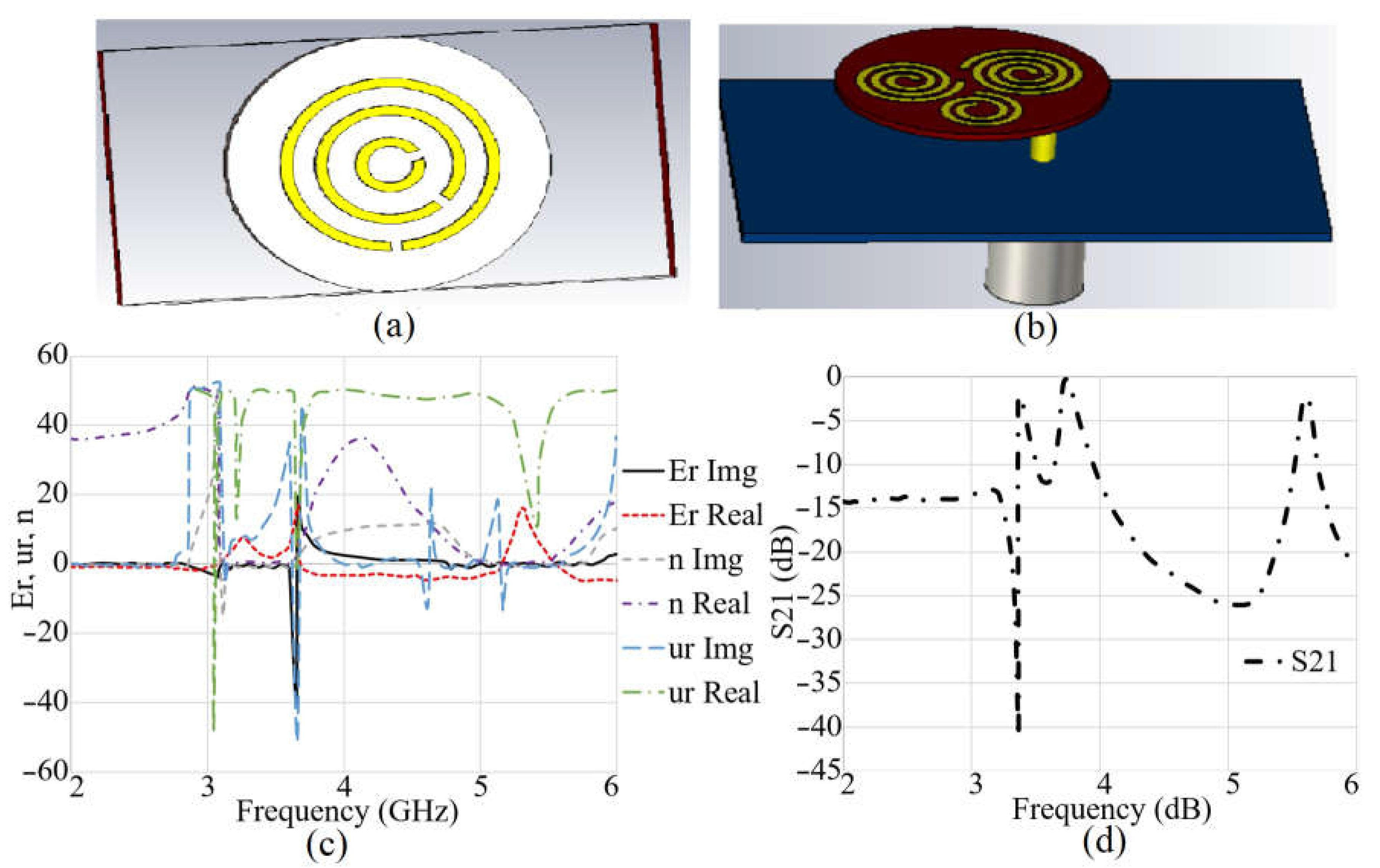
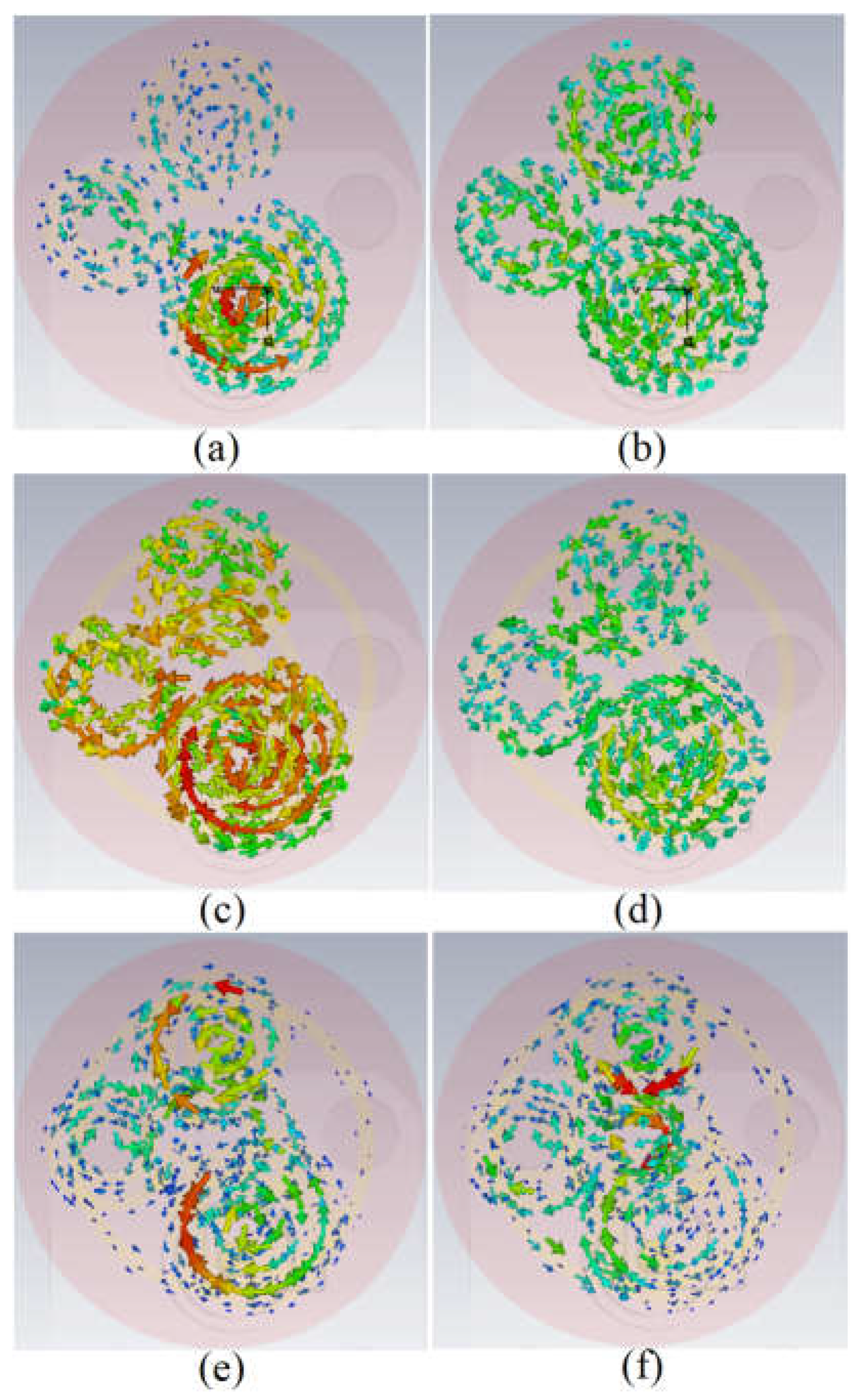
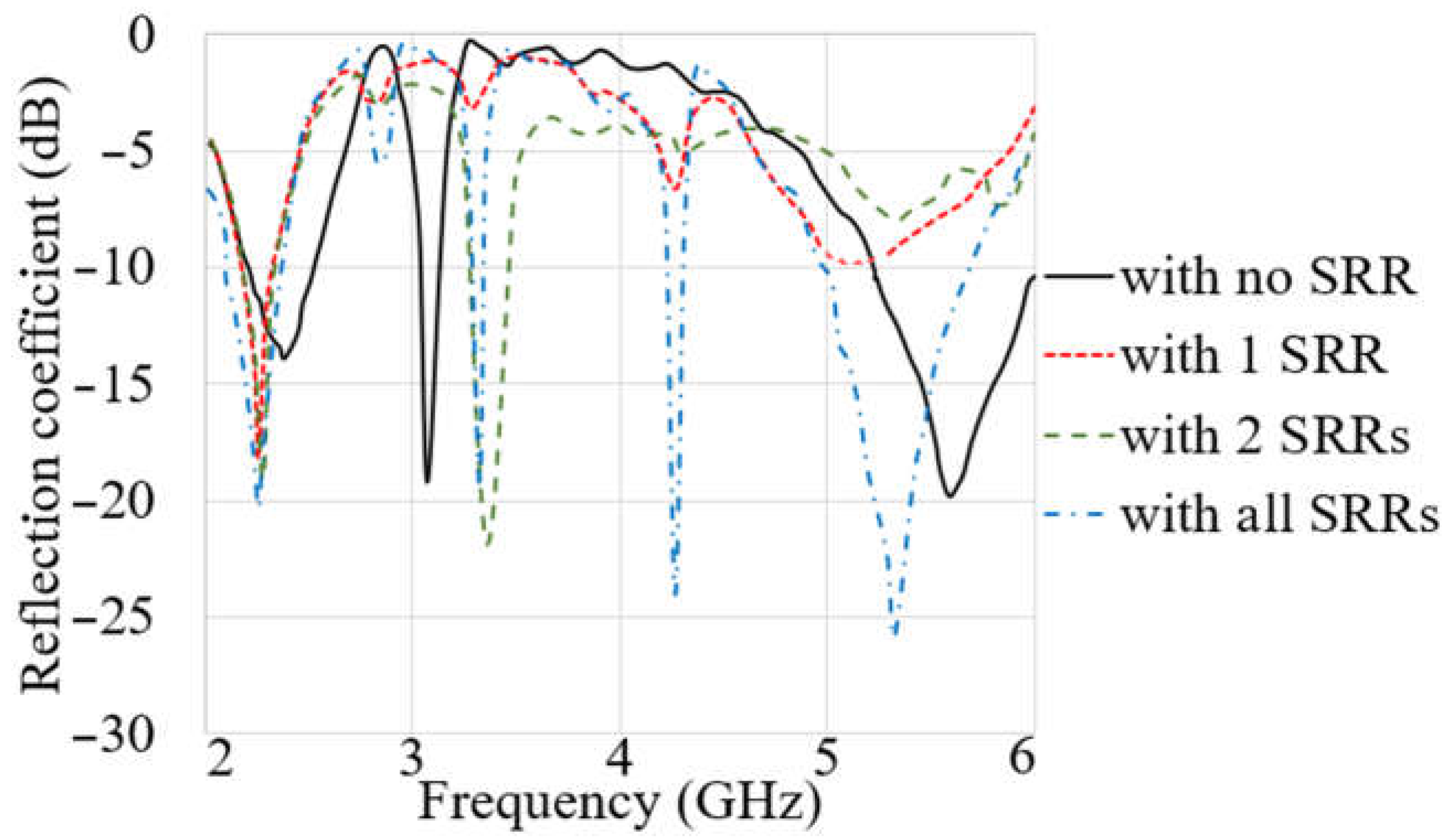

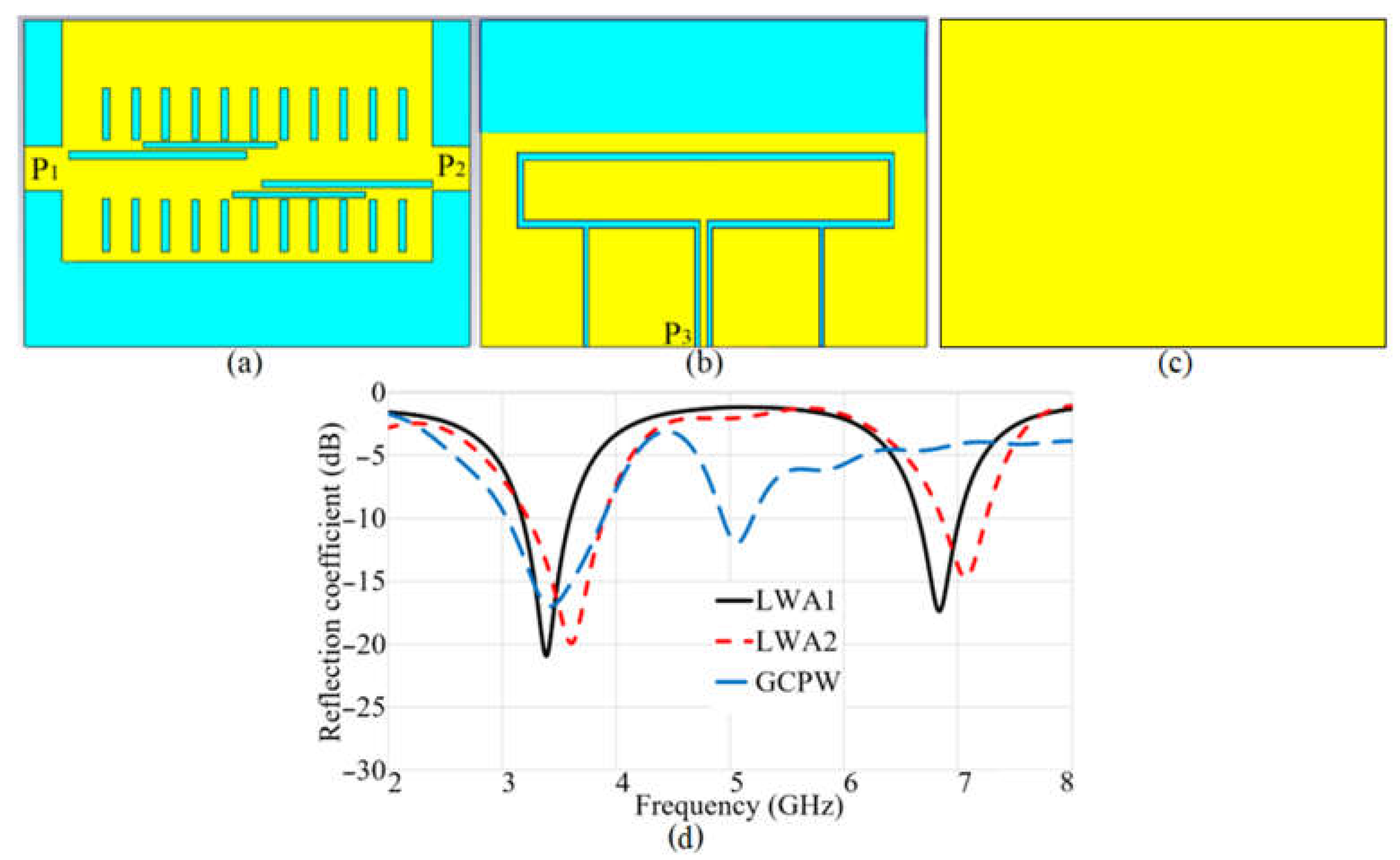
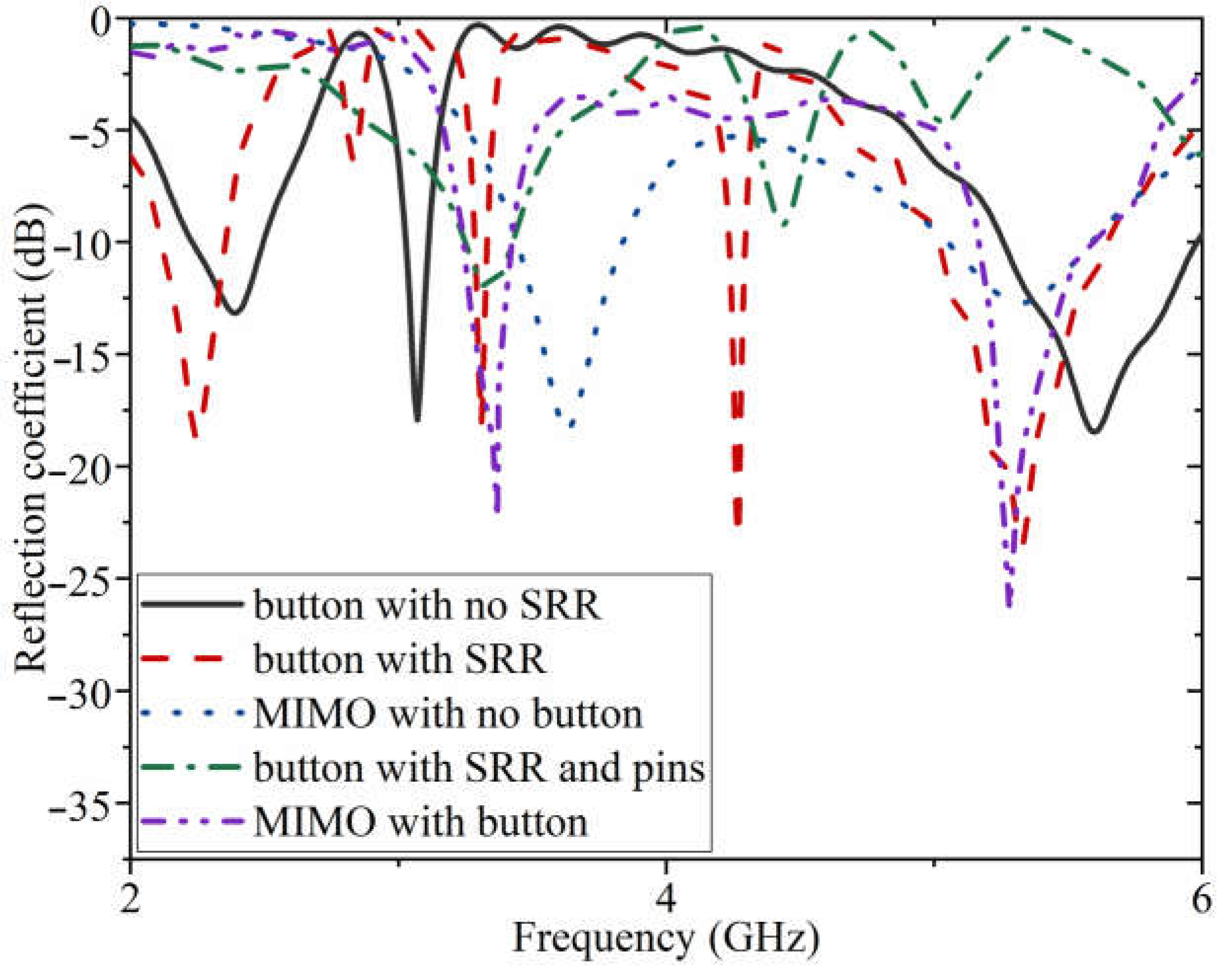





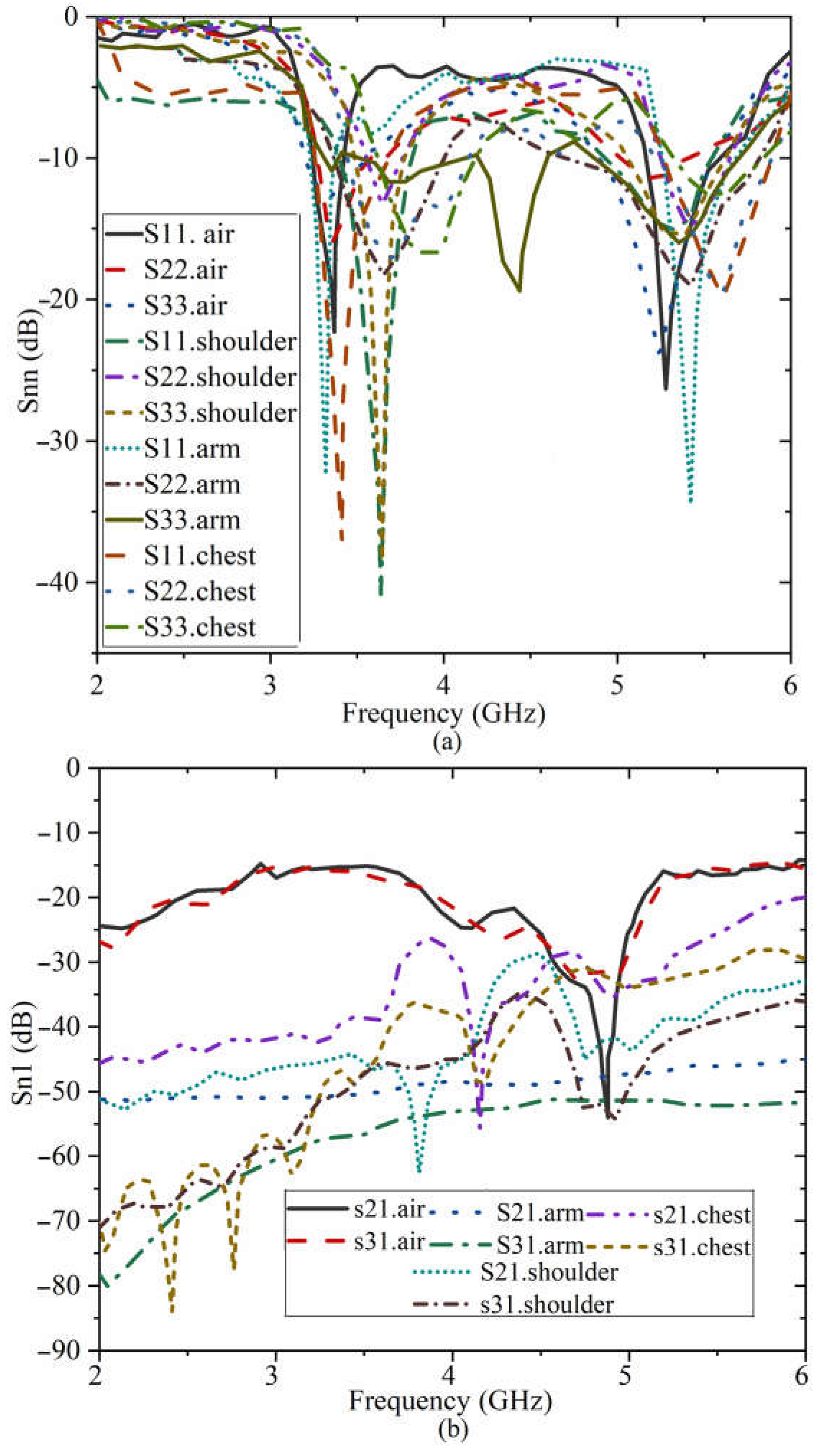
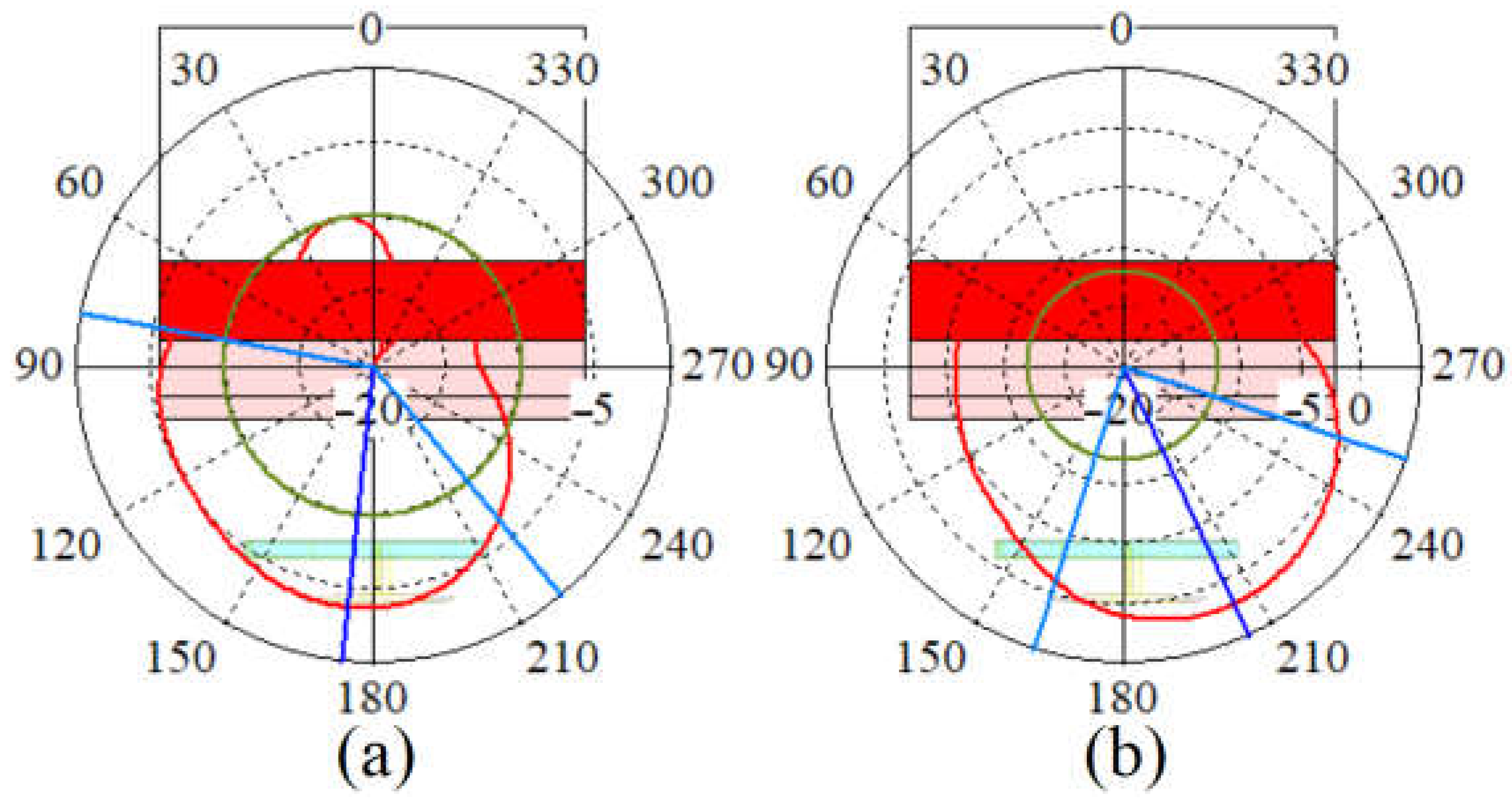
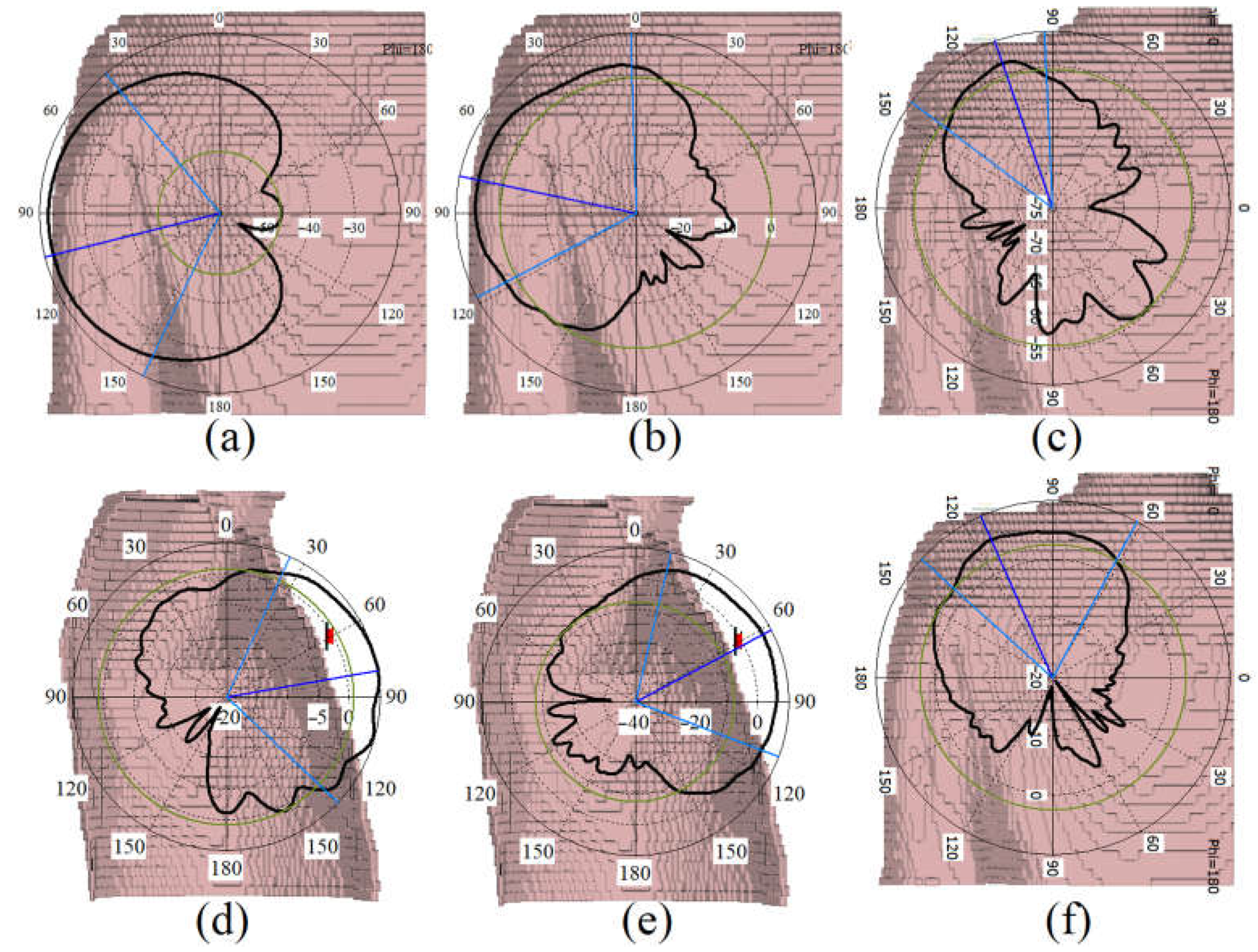

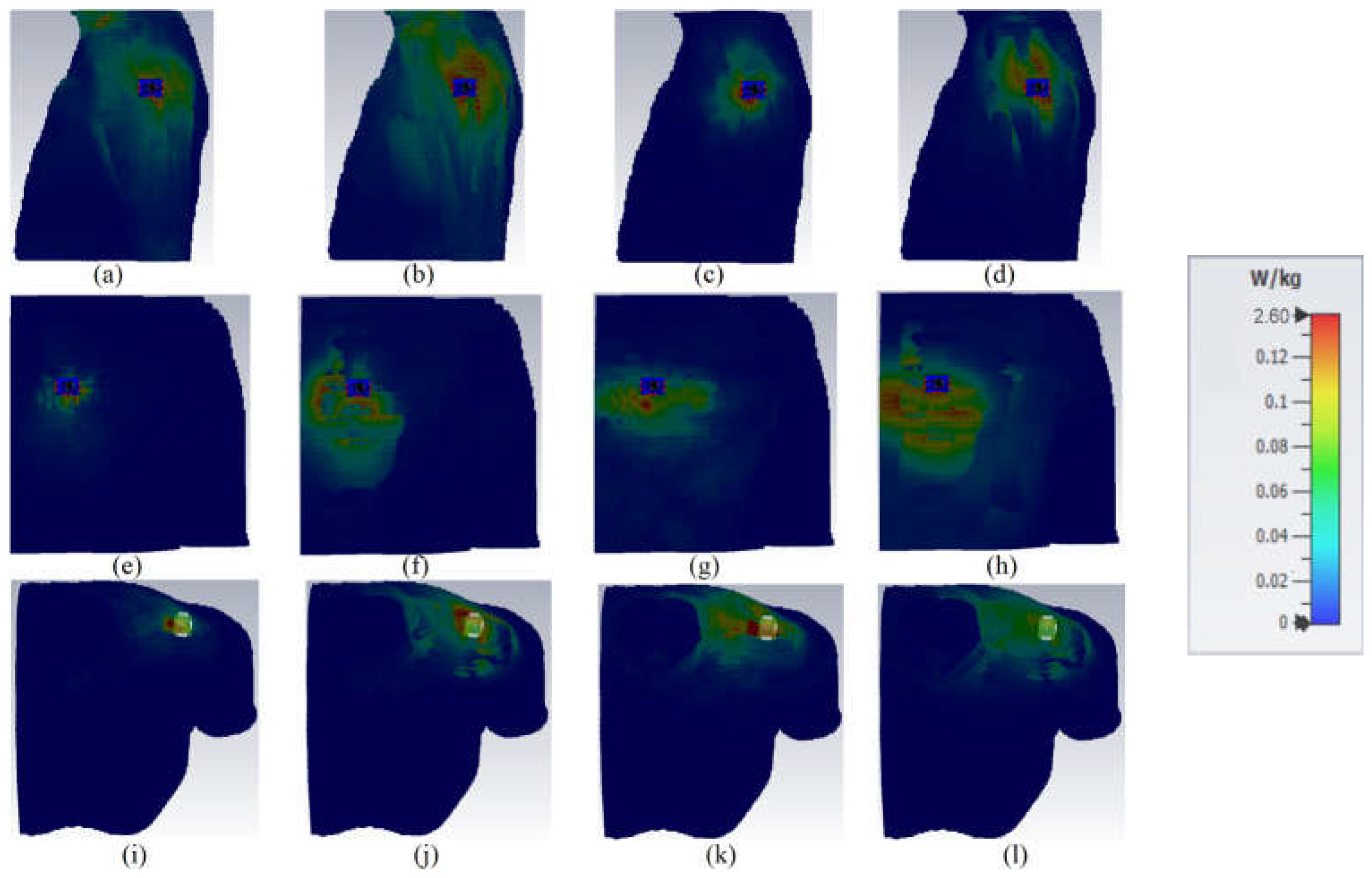


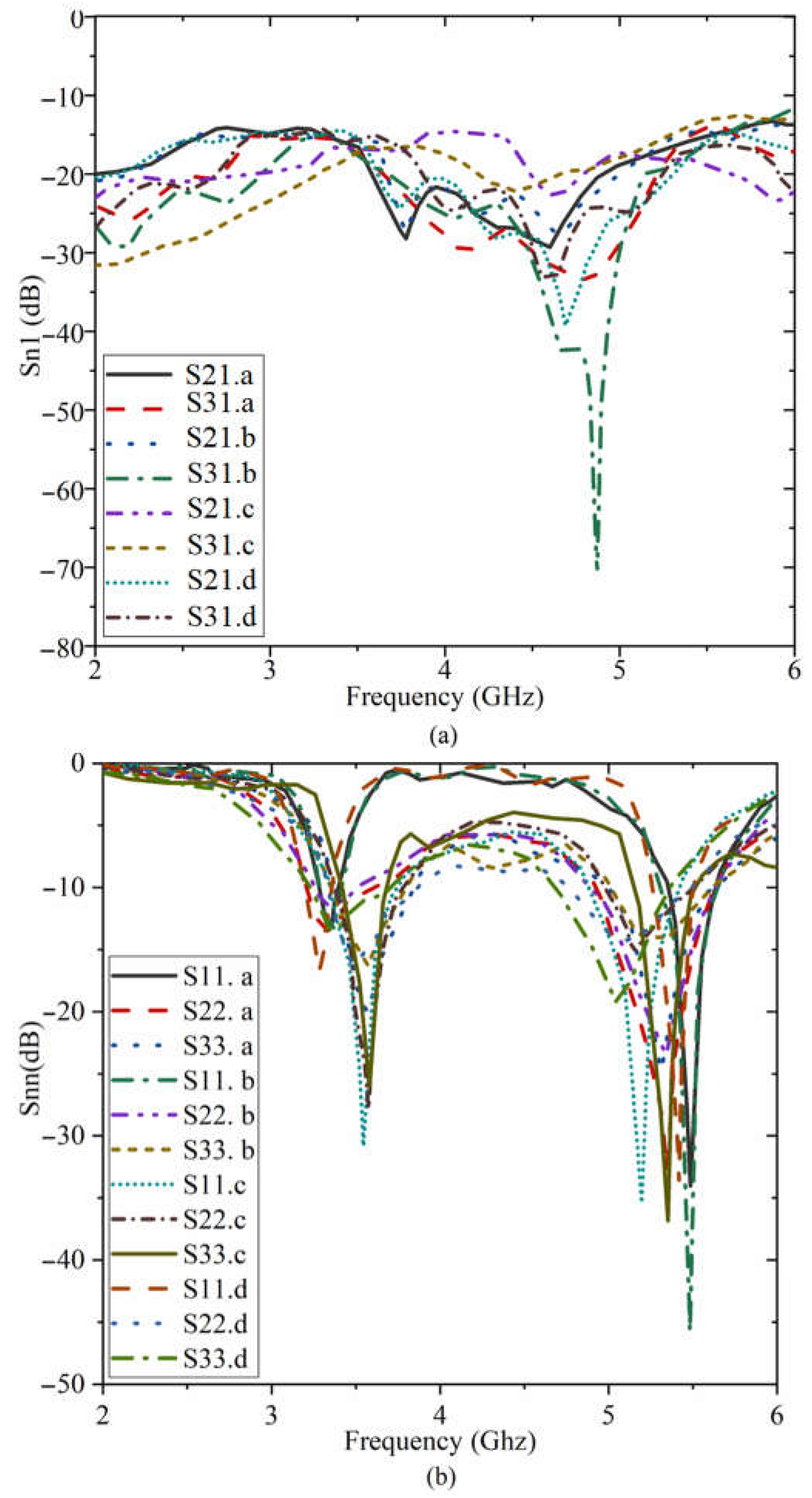
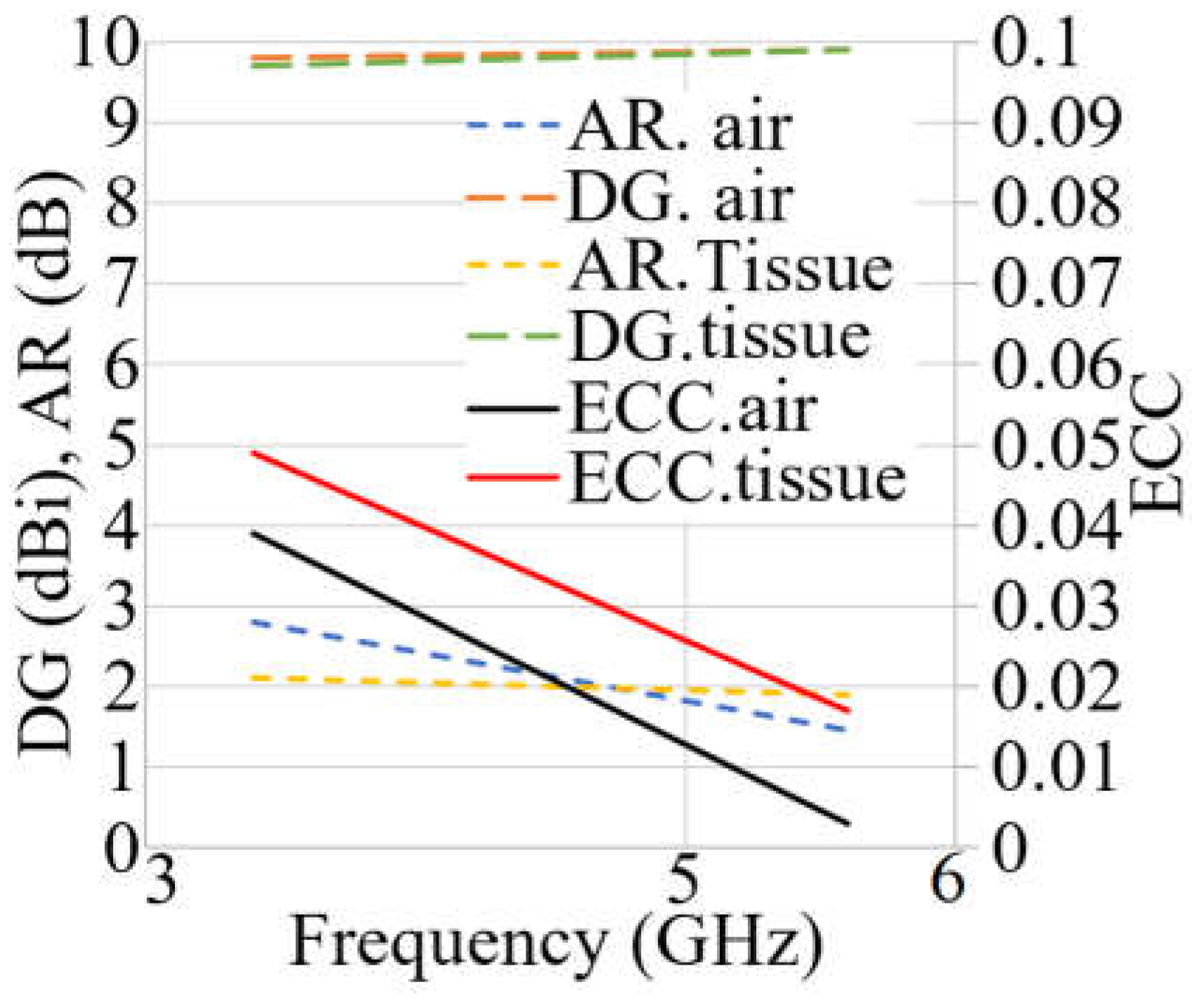
| Param | fr (GHz) | Polarization | Peak Gain (dBi) | Size (mm) L × W | Designed Technique | Eff (%) | Material | Isolation (dB) | |
|---|---|---|---|---|---|---|---|---|---|
| Ref | |||||||||
| [38] | 2.45 | CP | 2.36 | 0.32λ0 × 0.32λ0 | DGS | N/A | FR4 | <25 | |
| [39] | 5.8 | N/A | <8.5 | 0.73λ0 × 1.1λ0 | EBG, MTS | <83 | Rogers 5880 | <34.8 | |
| [40] | 3.57 | N/A | <5 | 0.70λ0 × 0.65λ0 | Partial GND | N/A | Jeans | <19 | |
| [41] | 2.45 | N/A | 0.5 | 0.22λ0 × 0.2λ0 | Partial GND | <40 | Rogers 5880 | <30 | |
| [42] | 6.5 | N/A | 5.88 | 0.7λ0 × 0.7λ0 | Partial GND | N/A | Jeans | <22 | |
| [44] | 6 | Ver, Hor | 4.62 | 0.52λ0 × 0.52λ0 | Partial GND | 93 | Polyester | <17 | |
| [45] | 1.1 | N/A | 7.5 | 0.19λ0 × 0.13λ0 | Partial GND | <90 | cotton and felt | <30 | |
| [46] | 2.4 | N/A | N/A | 0.44λ0 × 0.13λ0 | Stub at GND | <80 | Jeans | <19 | |
| [47] | 3.1 | LP | 3.41 | 1.1λ0 × 0.18.4λ0 | Connected ground plane | 89.3 | Silicon rubber | <25 | |
| [48] | 6 | N/A | <8 | 0.76λ0 × 0.76λ0 | CPW | <98 | LCP | <22 | |
| [49] | 3.55 | Dual | <8.5 | 0.8λ0 × 0.8λ0 | SIW, matching cavity | <93 | Rogers RO4350 | <18 | |
| [50] | 5.3 | CP | <4 | 0.87λ0 × 0.79λ0 | Partial GND | N/A | FR4 | <20 | |
| Parameters | Final Values (mm) | Parameters | Final Values (mm) | Parameters | Final Values (mm) | Parameters | Final Values (mm) |
|---|---|---|---|---|---|---|---|
| 22.50 | 33.00 | 0.50 | 1.00 | ||||
| 15.72 | 25.00 | 0.25 | 0.25 | ||||
| 2.10 | 1.00 | 0.50 | 0.50 | ||||
| 3.50 | 0.50 | 0.50 | 0.25 | ||||
| 7.00 | 1.00 | 0.50 | 6.00 | ||||
| 1.30 | 0.50 | 3.00 | 1.15 | ||||
| 3.80 | 0.525 | 2.50 | 2.25 | ||||
| 3.3 | 6.3 | 7.5 | 5.50 | ||||
| 7 | 0.35 | 0.25 | 0.50 |
| fr (GHz) | 3.4 | 5.6 | |
| Free space | Gain (dBi) Sim/Meas | 5.7/4.1 | 7.81/7.24 |
| Eff (%) | 89 | 92 | |
| On tissue | Gain (dBi) | 4.27 | 6.6 |
| Eff (%) | 88.71 | 89.01 | |
| SAR (1 g/10 g) | 0.074/0.025 | 0.265/0.138 | |
| On chest | Gain (dBi) Sim/Meas | 5.16/- | 6.31/5.15 |
| Eff (%) | 82.81 | 90.99 | |
| SAR (1 g/10 g) | 0.05/0.02 | 0.002/0.001 | |
| On arm | Gain (dBi) Sim/Meas | 5.45/- | 6.82/6.51 |
| Eff (%) | 85 | 89 | |
| SAR (1 g/10 g) | 0.031/0.021 | 0.36/0.191 | |
| On shoulder | Gain (dBi) Sim/Meas | 5.05/- | 7.18/- |
| Eff (%) | 85 | 91.5 | |
| SAR (1 g/10 g) | 0.512/0.534 | 0.36/0.355 | |
| References | Freq. (GHz) Off/On | Dual Band | Polarization | Max Eff (%) | Max Gain (dBi) | Dim (mm) L × W | DG | Tilting/Bending Analysis | ECC |
|---|---|---|---|---|---|---|---|---|---|
| [1] | 3.5 | No | N/A | 82 | N/A | 0.81λ0 × 0.4λ0 | N/A | No | <0.17 |
| [2] | 2.55 | No | Orthogonally | 74 | 3.2 | 0.43λ0 × 0.43λ0 | Yes | No | <0.36 |
| [5] | 2.4 | No | triple | 51.4 | 3.8 | 0.42λ0 × 0.42λ0 | N/A | No | <0.37 |
| [7] | 2.3, 2.5, 2.4, 3.4–3.6 | Yes | N/A | 70 | 5 | 0.50λ0 × 0.65λ0 | N/A | No | <0.1 |
| [88] | 5.8 | No | LP/CP | 85 | 4 | 0.56λ0 × 0.92λ0 | N/A | No | <0.01 |
| [89] | 4.8–10.6, 8.1–10.8, 7.2–9.8 | Yes | N/A | 70 | 7 | 0.45λ0 × 0.45λ0 | No | No | <0.08 |
| [90] | 2.74–12.33 GHz | No | N/A | N/A | 6.9 | 0.50λ0 × 0.31λ0 | 9.9 | No | <0.025 |
| [91] | 3.2–3.85, 5.15–5.35, 5.72–5.82 | Yes | LP | 93 | N/A | 0.26λ0 × 0.23λ0 | 10 | No | <0.06 |
| This work | 3.25–3.65 GHz, 5.4–5.85 GHz | Yes | LP/CP | 92.7 at 5.6 GHz | 7.2 at 5.6 GHz | 0.37λ0 × 0.25λ0 | 10 | Yes | <0.05 |
Disclaimer/Publisher’s Note: The statements, opinions and data contained in all publications are solely those of the individual author(s) and contributor(s) and not of MDPI and/or the editor(s). MDPI and/or the editor(s) disclaim responsibility for any injury to people or property resulting from any ideas, methods, instructions or products referred to in the content. |
© 2023 by the authors. Licensee MDPI, Basel, Switzerland. This article is an open access article distributed under the terms and conditions of the Creative Commons Attribution (CC BY) license (https://creativecommons.org/licenses/by/4.0/).
Share and Cite
Saeidi, T.; Al-Gburi, A.J.A.; Karamzadeh, S. A Miniaturized Full-Ground Dual-Band MIMO Spiral Button Wearable Antenna for 5G and Sub-6 GHz Communications. Sensors 2023, 23, 1997. https://doi.org/10.3390/s23041997
Saeidi T, Al-Gburi AJA, Karamzadeh S. A Miniaturized Full-Ground Dual-Band MIMO Spiral Button Wearable Antenna for 5G and Sub-6 GHz Communications. Sensors. 2023; 23(4):1997. https://doi.org/10.3390/s23041997
Chicago/Turabian StyleSaeidi, Tale, Ahmed Jamal Abdullah Al-Gburi, and Saeid Karamzadeh. 2023. "A Miniaturized Full-Ground Dual-Band MIMO Spiral Button Wearable Antenna for 5G and Sub-6 GHz Communications" Sensors 23, no. 4: 1997. https://doi.org/10.3390/s23041997






